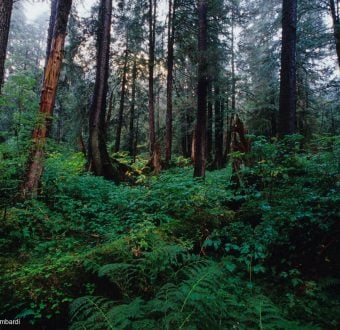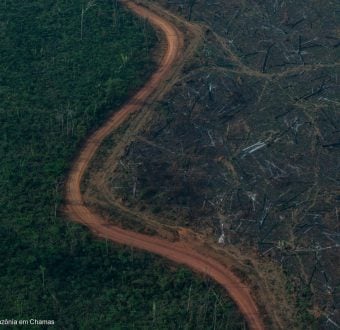 Just a few days before the next round of international climate negotiations begins in Mexico, a new Greenpeace report(1) released today titled “PROTECTION MONEY”, shows how the ‘showcase’ deal – due to be announced in Cancun – could be undermined. Current expansion plans, pushed by industry with support within some Government ministries, seek to triple pulp & paper production by 2025 and double palm oil production by 2020, with additional targets for agriculture and biofuel production. This expansion, coupled with weak definitions for degraded land in Indonesia could see REDD funds, which are designed to support protection of Indonesia’s forests and peatlands, actually being used to support their destruction.
Just a few days before the next round of international climate negotiations begins in Mexico, a new Greenpeace report(1) released today titled “PROTECTION MONEY”, shows how the ‘showcase’ deal – due to be announced in Cancun – could be undermined. Current expansion plans, pushed by industry with support within some Government ministries, seek to triple pulp & paper production by 2025 and double palm oil production by 2020, with additional targets for agriculture and biofuel production. This expansion, coupled with weak definitions for degraded land in Indonesia could see REDD funds, which are designed to support protection of Indonesia’s forests and peatlands, actually being used to support their destruction.
The area earmarked for expansion by these sectors includes 40% of Indonesia’s remaining natural forest – an area the size of Norway and Denmark combined (2). Up to 80% of Indonesia’s remaining peatland is also at risk, as well as nearly 50% of remaining forested orangutan habitat in Kalimantan (3). Government figures suggest the forest and peatland carbon at risk amounts to 38GtC – equivalent to four years’ worth of global greenhouse gas (GHG) emissions. (4)
“President Susilo Bambang Yudhoyono (SBY) has a progressive vision for low-carbon development, and the deal between Indonesia and Norway could set a fantastic example of how the developed and developing world can work together to protect natural forests, and tackle climate change,” said Bustar Maitar of Greenpeace South East Asia.
“However, these plans are being systematically undermined by the influence of the palm oil and pulp and paper industry, which is intent on a business-as-usual expansion model that will destroy much of the country’s remaining rainforests and peatlands.”
Comparing Indonesia’s data with that of other top emitting countries shows that Indonesia is the world’s 3rd largest emitter of greenhouse gases, chiefly due to deforestation and peatland degradation. (5)
Government figures highlighted in the Greenpeace report show that, with an increased focus on productivity, the targeted increase in production for these industries can actually be achieved without further deforestation.(6)
”It’s clear that the palm and paper sectors can achieve expansion targets without damaging another hectare of forest. This would be a win for the industry and Indonesian economy, a win for forest communities and threatened species, and a model of the real-world solutions we need to tackle climate change,” concluded Maitar.
“Just days before President SBY announced the initiative with Norway, the sweeping Canadian Boreal Forest Agreement was unveiled with full support from the Forest Products Association of Canada. President SBY deserves similar support and collaboration from industry in Indonesia,” said Rolf Skar, Senior Forest Campaigner with Greenpeace U.S.
Greenpeace, together with a coalition of NGOs working in Indonesia, is calling for an immediate moratorium on the conversion of natural forests and the full protection of peatlands.
Greenpeace is an independent, global campaigning organisation that acts to change attitudes and behaviour, to protect and conserve the environment, and to promote peace.
Notes:
(1) Greenpeace Report: “PROTECTION MONEY”: http://www.greenpeace.org/international/en/publications/reports/Protection-Money/
(2) Greenpeace analysis based on 2010 Ministry of Forestry ‘Landuse maps (provincial planning maps/Forest Land Use by Consensus maps (TGHK)’ and 2009 Ministry of Forestry data for Landcover Indonesia 2006.
(3) Greenpeace analysis based on 2010 Ministry of Forestry ‘Landuse maps (provincial planning maps/Forest Land Use by Consensus maps (TGHK) 2009 Ministry of Forestry data for Landcover Indonesia 2006 and 2004 ‘Borneo Orangutan PHVA Habitats Units’ Meijaard et al, the most recent data available.
(4) Greenpeace analysis based on figures from a) DNPI ‘Indonesia’s greenhouse gas abatement cost curve’ August 2010 b) 2010 Ministry of Forestry Landuse maps (provincial planning maps/Forest Land Use by Consensus maps (TGHK)’ c) 2009 Ministry of Forestry Landcover Indonesia 2006 d) 2009 Ministry of Environment ‘Indonesia second national communication under the United Nations Framework Convention on Climate Change (UNFCCC) – Summary for policy makers’.
(5) Based on comparison of DNPI data (published 2009 and source for their 2010 report) with data from other top emitting countries (China, USA, Brazil, India, Russia) positions Indonesia is the world’s 3rd largest GHG polluter in 2005, the base line year from which the Government has made its abatement plans. See endnote 5 of ‘Protection Money’ report for full explanation.
(6) a) Pulpwood plantations work on a seven-year rotation. Indonesia’s assumed annual carbon uptake of 8tC/ha/yr (DNPI ‘Indonesia’s greenhouse gas abatement cost curve’ August 2010) implies a delivered productivity of 32m3/ha/yr = 224m3 at harvest. The maximum current national average harvest is 60m3 (Ministry of Forestry December 2009: Bina Produksi Kehutanan Data Release Ditjen BPK sd).
b) Palm oil: ‘It is feasible for the government to set 40 million tons of palm oil production without expanding plantations’, Deputy Agriculture Minister quoted September 28th 2010, ‘Step Up Palm Oil Production Without Expansion’ Media Indonesia www.mediaindonesia.com/webtorial/asianagri/eng/?ar_id=NzgyNg==
Contacts:
Greg McNevin, Greenpeace International Communications, [email protected]
Molly Dorozenski, Greenpeace USA Media Officer, [email protected]
—


